Sailfin Tangs (Zebrasoma veliferum) combine beauty, personality, and size into the perfect reef tank addition. They aren’t quite as aggressive as other members in the tang family, though they WILL establish their territories. Best of all, they’re a little easier to track down, and they WON’T break your piggy bank if you’ve lost your heart to their gorgeous colors and patterns.
Table of Contents: Sailfin Tang Care
Looking for something in particular? The following links can help you navigate through the various elements of sailfin tang care. Or you can read the entire article and learn everything there is to know about these enormous herbivores.
- Quick Facts
- Description of the Sailfin Tang
- Sailfin Tang Lifespan
- Creating the Ideal Sailfin World
- Sailfin Tang Diet
- Sailfin Tang Behavior and Tank Mates
- Breeding the Sailfin Tang
- Pros and Cons
- For More Information

Quick Facts
- Common Names: Pacific sailfin tang, Eastern sailfin tang, Ringed tang, Surgeonfish, Sail fin fish, Sailfin surgeonfish, Striped tang, (and when someone messes up the identification) Desjardin’s sailfin tang – which is an entirely different species
- Scientific Name: Zebrasoma veliferum
- Size: Up to 15 inches (38.1cm)
- Minimum Tank Size: 125 Gallons (473L)
- Reef Safe? Safe (Mostly)
- Care or Experience Level: Easy to Moderate
- Preferred Diet: Herbivore
- Original Part of the World: South Pacific
Description of the Sailfin Tang
As with most tangs, the sailfin tang saltwater fish sports a flattened, disc-shaped body. They have an incredible dorsal fin that extends out into an impressive sail. Combined with their long anal fin, it comprises the bulk of their impressive 15-inch (38.1cm) length. It’s actually where their scientific name comes from. “Velifer” is the contraction of velum (“sail”) and fero (“wear”) in Latin. Thus, this impressive saltwater fish wears around a personal sail.
As youngsters, sailfins have scales of a soft brown with yellow stripes. You also see more of that brilliant yellow hue spread throughout the fins, tail, and over the nose. As they shift into adults, the body darkens with olive tones while the stripes get paler.
It’s a similar pattern to the Red Sea sailfin tang (or Desjardin’s sailfin). However, Red Sea sailfins lack the impressive sail and have white freckles over the front third of their body. When you compare the two side by side, it’s easy to tell them apart. (And makes you wonder how people confuse one for the other.) Not to mention they’re NOT found in the same part of the ocean.
As with all surgeonfish, sailfins have “scalpels” on either side of the caudal peduncle (the base of the tail). It’s what makes them surgeonfish (get it?). This defensive measure keeps them safe from predators while also reinforcing the famous tang aggression. When not in use, the spines remain folded within special grooves. You should ALWAYS stay aware of their presence, though. Unless you WANT to experience a painful injury, anyway.
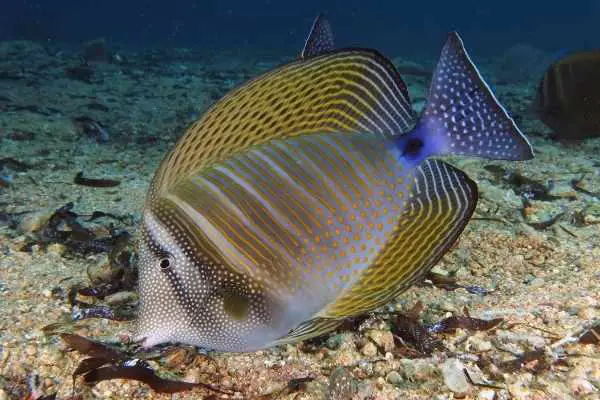
Sailfin Tang Lifespan
Sailfin tangs patrol throughout lagoons and reefs throughout the southern Pacific and Indian Oceans. They prefer to hang out on their own, maintaining patrols. It’s a somewhat stressful life that keeps their lifespan between 5-7 years. In a captive setting, where you keep things under better control, you’ll probably get a few more years.
Creating the Ideal Sailfin World
Sailfin tangs cruise water between depths of 3-200 feet in their natural habitat. They love a strong water current, where they swim throughout turbid reef systems. On an average day, they hide out among rocks and corals, darting out to chase off interlopers that happen into the area. Divers see them everywhere from Hawaii to the Great Barrier Reef and up to the Tuamoto Islands. You have plenty of colorful regions to take your inspiration from.
Of course, it means you also need to keep that water current in mind. If you don’t already have several powerheads in place on your marine tank, get a few more. These are WIDE fish. And nothing makes their hearts go pitter-patter quite like the rush of saltwater over their gills. Well, water AND oxygen. Those powerheads will not only move the current around, it’ll agitate the surface and supply additional aeration. The combination of the two will keep your sailfin swimming about happily.
And while sailfin tangs drift as far down as 200 feet, they prefer the shallower waters. You can split the difference by using quality LED lighting with plenty of hiding places to provide dim shadows. You’ll want those rocks, anyway. They offer needed grazing spots AND a site for the sailfin to seek refuge. They’re the perfect balance between the sailfin’s particular needs.
Before you get too carried away and bring a sailfin tang home, though, check your water quality. These are hardy saltwater species – AFTER a reef tank’s cycled. You’ll want at least six months of full, healthy nitrogen cycling to pass before you consider introducing a sailfin. If you don’t wait, you’ll risk your new tang succumbing to illness. They’re FAMOUS for marine ich.
Sailfin Tang Tank Size
Remember, sailfin tang are saltwater aquarium fish that get HUGE. And while the juveniles aren’t quite as large as the adults, it takes almost no time for the fish to grow. Rather than scrambling to change tanks after a few months, start yourself on the right foot from the beginning. At the minimum, go for a 125-gallon (473L) tank. Realistically, though, the bigger, the better. A 200-gallon (757L) tank will make your sailfin happiest.
And while it’s tempting to fit in as much coral and live rock as possible, think of the swimming room these fish need. You want to make sure your sailfin can turn around at either end of the aquarium without a problem. And that means with the sail at full extension. They need their hiding places, but not at the expense of room to explore and stretch their fins.
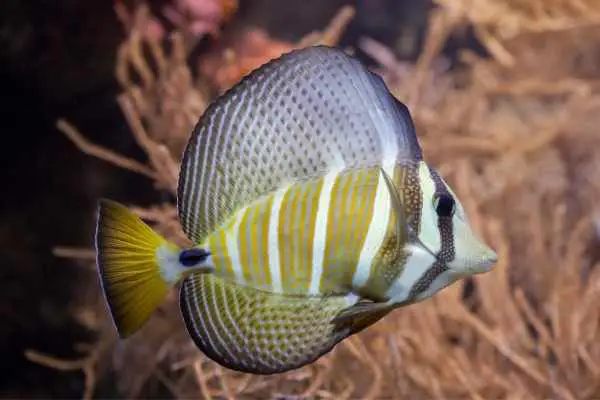
Are Sailfin Tang Reef-Safe?
In general, there’s no problem adding sailfin tangs into a reef tank. They’re herbivores, preferring to snack on algae throughout the marine system. Your only concern may be the possibility that your sailfin can nip at coral polyps during the grazing process.
If you do your aquascaping properly, though, you should be able to space the live rock out such that you’ll protect your corals. And, honestly, it’s a minor concern. But it’s still something to keep in mind.
Sailfin Tang Diet
Sailfin tangs adore microalgae – the tiniest plants in the entire reef system. One more reason to love them, right? However, if you have other herbivores in the tank – such as cleaner shrimp – there may not be enough food to go around. That means you’ll need to supplement the menu.
And if you’re hoping for a cure to obnoxious bubble algae, you have the wrong species. That’s the purview of the Desjardin sailfin tang. They’ll eradicate the pest for you. Of course, they’re smaller and come from a different region (the Red Sea). However, since people frequently mix the two up, you may get lucky!
When you’re supplementing the diet, though, you have nothing to worry about. Sailfins are easy to feed, and they’re not picky. You can offer them daily feedings of flakes or pellets containing spirulina. You can also supplement them with veggies from your trip to the market:
- Broccoli
- Lettuce
- Spinach
- Zucchini
And it sounds comical (or maybe reasonable?), but nori works as an excellent substitute. The dried kelp sheets sink in the water (or you can use a veggie clip), and they supply plenty of nutrients.
You can also supplement the diet with mysid or brine shrimp. Yes, of course, they’re herbivores, but no fish is 100% one thing or another. (Well, omnivores are 100% omnivores, but that’s an easy thing) The protein keeps their colors looking their best. You’ll get a nice dose of vitamin C, too, which will help prevent lateral line erosion. (Balanced diets do everyone a world of good)
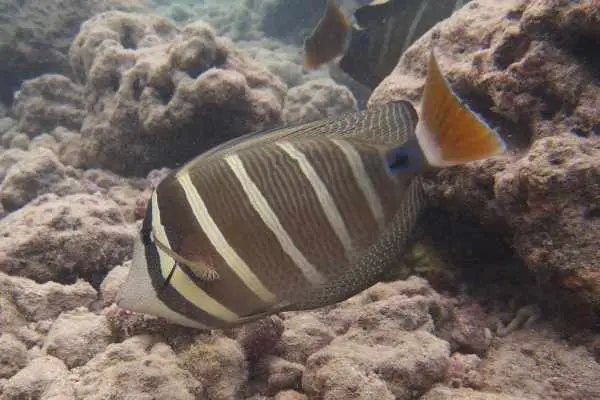
Sailfin Tang Behavior and Tank Mates
Who wouldn’t want an entire reef tank of sailfin tangs? It sounds gorgeous, but it’s a pipe dream. Aside from the logistics of managing an aquarium that large, sailfins don’t play well with their own. It isn’t just them, either. The majority of the surgeonfish family would rather not deal with one another. Remember that scalpel? Yeah – total carnage.
Sailfins set up territories in the wild and captivity. When confronting each other, they use those scalpels – in deathmatches. Unfortunately, despite their impressive size, sailfins often come out the LOSERS when paired up with other tangs. You’re much better off having ONE sailfin as a centerpiece in a reef tank. Then everyone stays happy and healthy.
With other fish, sailfins mind their manners – most of the time. They can bully and chase around new additions to the tank. This is another reason to hold off on adding a sailfin tank until the last moment. Otherwise, though, you’re usually safe. If they feel threatened by a larger fish, they’ll extend their dorsal and anal fins to appear bigger and more menacing. (It’s a show; they’re the biggest scaredy-cats in the ocean) When threats don’t dissipate, they rely on their scalpels. It can’t kill another fish, but the spine is painful, urging the fish to LEAVE.
Sailfins get along well with cleaner wrasses, neon gobies, and cleaner shrimp. All three help remove parasites from their scales. Unfortunately, cleaner wrasses are often challenging to track down. You may want to try for a neon goby or cleaner shrimp instead.
Breeding the Sailfin Tang
Picking out males from females in the sailfin tang universe isn’t the easiest thing in the world. You can see a SLIGHT size difference, but unless you happen to catch a pair during a courtship ritual, you could spend a lot of time questioning your eyesight. (And since they’re not fans of hanging out together, that could pose problems, too)
In the Pacific, sailfin spawning matches up with the cycle of the moon. Males flash a color-changing performance to attract a female’s attention. It’s impressive – and not just to the female sailfin. Males are polygamous, which means they’ll visit as many females in a single spawning cycle as they can. Females, on the other hand, only produce one batch of eggs a month. The eggs are then scattered throughout the reef. And that’s about the extent of parental involvement for the sailfin tang, too. The tiny fry are on their lonesome in the big vast ocean.
For the first three days, the fry subsist on the attached egg yolk. After around day four, they start to forage for plankton. Slowly, they develop the compressed shape tangs are so well-known for. They also produce protective razors on the dorsal and ventral fins. It’s the best defense these little fry get since their parents took off after conception. They lack scales, and they have a transparent shape. Unique to the Acanthuridae family, they’re known as acronurus larvae.
As the youngsters mature, their bodies take on an oval shape similar to the adults. They also get a more identifiable caudal peduncle. It sets up the housing for that tang scalpel. The scales turn opaque first, and then the colors fill in.
You won’t see much of a difference if you choose to breed sailfins in your reef tank. It’ll probably help to keep a lunar calendar handy, so you know when to expect eggs to appear. Unhappily, since tangs don’t like each other, you could struggle with success. Make sure you have the largest tank size possible to keep territories separate OUTSIDE of the full moon.
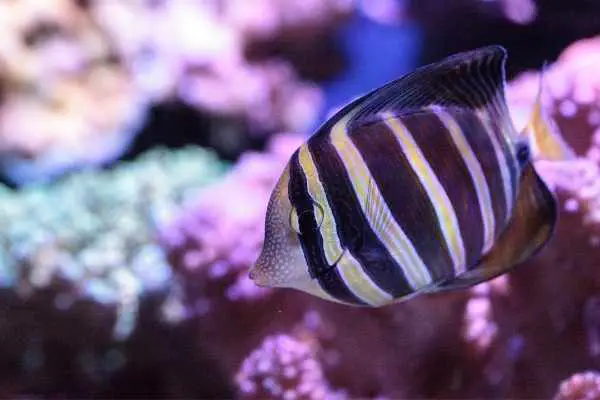
Pros and Cons
Sailfin tangs impress with their size and colors. Not to mention that people picked up a fascination with the tang group courtesy of Finding Nemo and Finding Dory. But before you rush to add a sailfin to your aquarium, make sure you weigh the pros and cons of these monsters:
Pros
- The beautiful scales of a sailfin tang require frequent upkeep. It’s the perfect excuse to invest in a cleaner shrimp for your marine tank – assuming you don’t have any already.
- Tangs feed on algae. They’re constant eaters, fueling an active metabolism. You need to make sure you balance their diet, but they’re an excellent addition to the cleaning crew in your aquarium.
- Of the various tang species available, sailfins have one of the better personalities out there. They still set up territories, but if you add them to the tank last and skip any other tangs, they’re not likely to pick fights with the other residents.
Cons
- Surgeonfish all come with a sharp “scalpel” on either side of the tail. It provides defense. You probably won’t suffer lasting harm if your sailfin tang happens to catch you with the spine, but you can’t forget its presence.
- Sailfins produce less mucus than other saltwater species. This makes them prone to diseases such as marine velvet and marine ich. You should ALWAYS set up a quarantine for TWO WEEKS before you add them to your tank.
- The lack of a boisterous, hardy immune system means you need to work a little harder on the tank maintenance. Sailfins do best with regular, small water changes, protein skimming, and hefty filtration.
For More Information
Sailfin tangs fascinate people. Between their size and that scalpel, there’s so much to learn and explore. Good thing there’s more information for you below!
This YouTube video shows a sailfin cleaning station at work. They’re big fish, and they need all the help they can get removing unwanted pests.
And, of course, now you want to see your cleaning station in action. That means learning about cleaner shrimp:
Want to learn more about the best sailfin tank mates?
Or maybe you’d like to explore other members of the tang family. There are plenty of tang species that look every bit as stunning – even if they’re smaller:
Unfortunately, sailfins are prone to A LOT of ailments. What’s better than arming yourself with some knowledge before you bring one home?
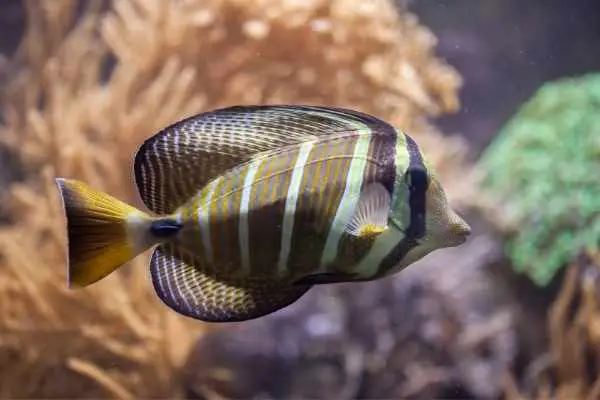
Conclusions
Sailfin tangs have an enormous sail that stretches out to impressive lengths. They also look stunning in their stripes of yellow-gold. Whether they’re poking around corals in the southern Pacific or exploring live rock in your reef tank, they draw attention. People WANT to spend time staring at them.
You need to take care of your water quality to keep your sailfin as healthy as possible, though. It means waiting an extra two weeks of quarantine before mixing them in with the others, but safety first. The additional work will pay off once you see your tang swimming around.
References
- Fenner, Robert. 2015. Surgeonfishes: Tangs for Marine Aquariums: Diversity, Selection & Care.
- Kuiter, R.H. and Debelius, H. 2001. Surgeonfishes, Rabbitfishes, and Their Relatives. A Comprehensive Guide to Acanthuroidei.
- Randall, John E. 2002. Surgeonfishes of the World.


Leave a Reply